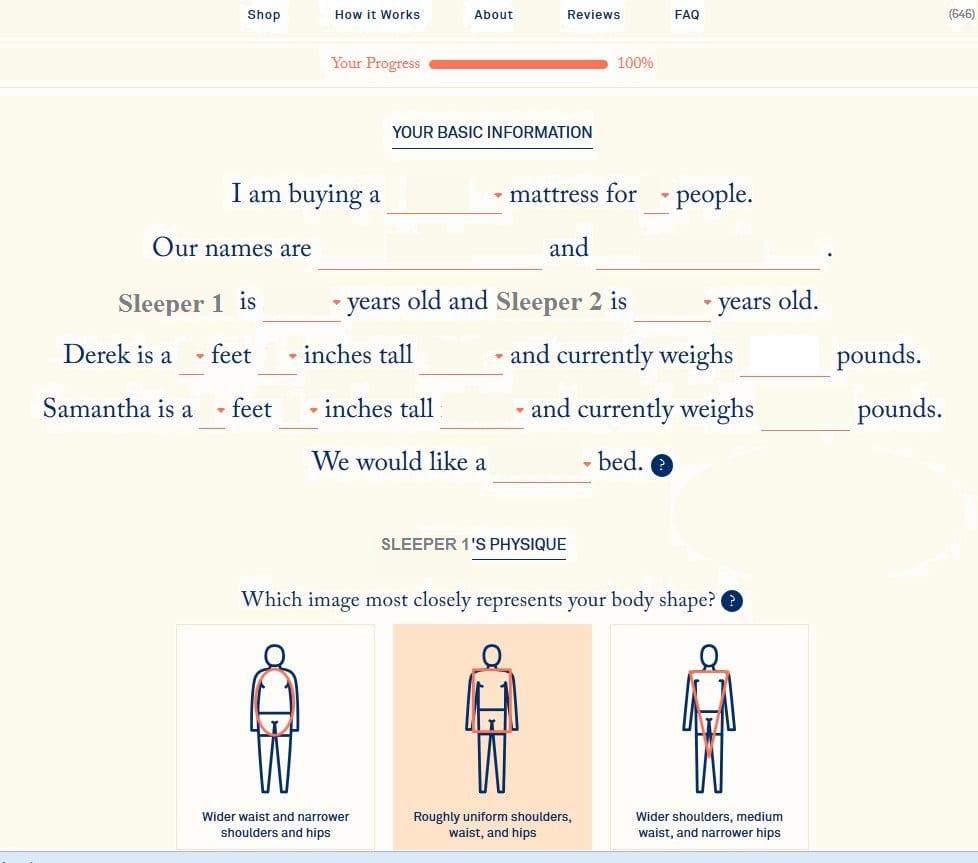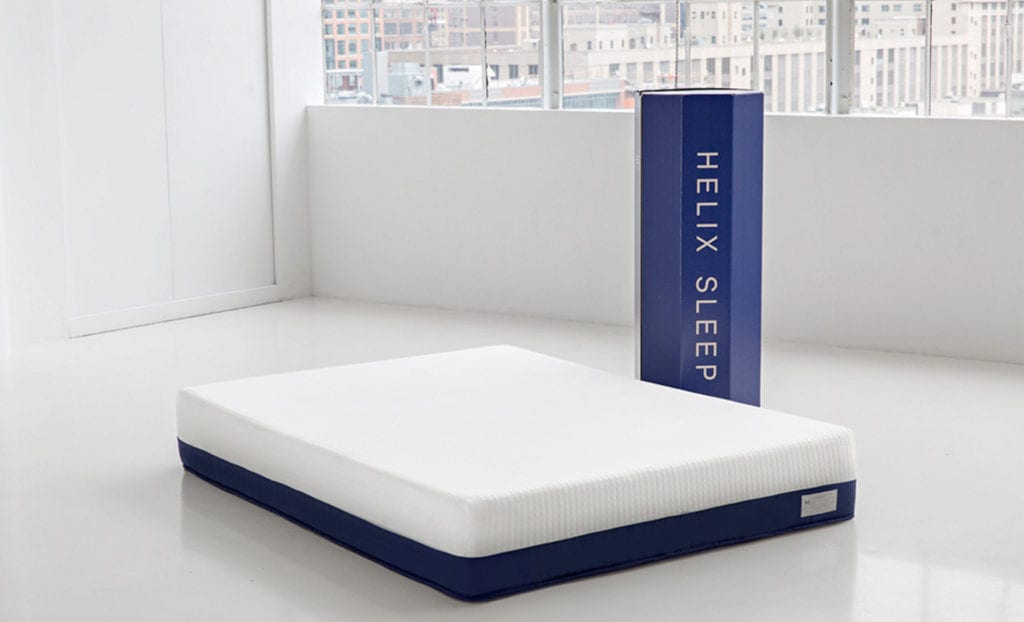The Helix Difference
Helix Sleep entered the mattress market practically on the heels of Casper Sleep. They are both members of Mattress 2.0, the current boxed bed movement, selling mattresses ordered online instead of in stores for a fraction of the price and shipping them compressed, rolled and put into boxes (Helix‘s box is cylindrical). But on one point, they are at opposite ends of the scale. Casper has only one model at only one comfort level (firmness), as do Yogabed and a few others. Some have two or three firmnesses to choose from. Helix, on the other hand, fully customizes each mattress for the individual user or couple. CrunchBase called Helix “The Most Algorithmic Design.”
Helix Sleep was founded by three Ivy League MBA students (Jerry Lin, Adam Tishman, and Kristian von Rickenbach) who were dissatisfied with their mattress shopping experiences. The stated goal is to make a better experience for their customers.
Though the Helix Mattress is generally available only online, they do have a showroom in New York City where it can be seen and tried out first-hand, ordered, purchased, and designed. Helix Sleep says, “During a 30 minute appointment in our NYC showroom, a Helix Sleep expert will walk you through the personalization process, show you the materials that will be used in your mattress design, and build you your customized mattress on the spot. Napping is highly encouraged.”
The Latex Factor
A key component of the Helix mattress is synthetic Dunlop latex in the 2” top layer. Using synthetic latex with the Dunlop process avoids allergies caused by proteins in natural latex sap. In the costlier Talalay process, these proteins are rinsed away. A blended latex has the better feel of natural latex, but with the greater durability of the synthetic.
With other materials in the comfort layers of the mattress, this is a latex hybrid. There are at least four other Mattress 2.0 brands of latex hybrids with latex at the top: Casper, Dream Bed (by Mattress Firm), and GhostBed. Two other latex hybrids, Fibro-Pedic and Soft-Pedic (by Selectabed), have memory foam at the top and zoned latex underneath.
Another brand, Leesa, uses Avena, a latex substitute in the top layer. Still another boxed brand, #TheBestMattressEver by Brooklyn Bedding is a latex mattress, not a hybrid.
Why Latex?
Natural, synthetic or blended, Talalay or Dunlop, latex is naturally resilient, bouncy (latex foam was previously known as foam rubber). The foam can also be produced in a range of densities, to be softer or firmer, so it can be conforming, but with a quicker recovery than memory foam.
A More Diverse Hybrid
While most specialty sleep (non-innerspring) hybrid mattresses have more than one kind of foam besides the support core, the Helix Mattress not only has two kinds of foam, latex and polyurethane, but it also has 2¾” high microcoils between the latex and the high-density polyfoam comfort layer. The function of microcoils in comfort layers is to add to conformity for pressure relief. We can coin a term for this kind of hybrid mattress: Tribrid (or Trybrid).
The third Helix comfort layer is 2” of polyfoam (polyurethane foam). Polyfoam was used as the comfort layer in most foam mattresses before the introduction of memory foam.
The base layer (support core) of the Helix Mattress is 4½” of polyfoam firmer than that in the comfort layer. This is underlying support, keeping the upper layers from bottoming out.
The cover of the Helix is 100% polyester.
Personalization
The most used keyword on the Helix website is “personalization.” You do not just click, order and pay. You must first answer a few questions. The quiz is filling blanks on a form, and it takes about 2-4 minutes. The info asked for is:
• Mattress size
• Number of sleepers
• Name
• Age range
• Height
• Gender
• Weight
• Body shape
• Sleeping position
• How hot or cool
• Preferred firmness
• Evaluation of current mattress
• Rating of current sleep experience
• Medical conditions
• Neck or back pain
• Currently owned mattress (brand and model)

The personal questions are asked about the second sleeper if there are two. A couple is also asked whether they want a blended mattress (balance the needs) or dual comfort, and which side of the bed each sleeps on.
The computer at Helix analyzes this data and designs a mattress for the person or couple.
What Makes the Difference?
Since all Helix mattresses have the same 11¼” height, personalization depends on the constituent materials. The firmness of each foam layer is adjusted to bring the mattress (or that side) to the desired feel:
• The ILD (Impression Load Deflection) of the Dunlop latex ranges from 15 to 32
• The ILD of the the microcoils is 16
• The ILD of the 1.8-lb. polyfoam comfort layer ranges from 20 to 26
• The ILD of the 1.5-lb. polyfoam base (support) layer ranges from 26 to 33
For a blended mattress, these specifications are combined to give the best mattress overall for the couple. In a dual comfort mattress, each side of the mattress is designed for that sleeper, but it should not feel like two separate mattresses with a split in the middle. According to the independent mattress review site Sleepopolis (which gets mattresses and technical information from manufacturers), “These two mattress halves will be affixed and cured in the final stages of construction, forming one seamless mattress with a completely different feel on each side.”
Evaluation
Overall Ratings
Independent reviewers and customer reviews generally rate the mattress by Helix Sleep very high. According to Sleep Like the Dead, the Helix Mattress scores high on customer satisfaction, 82%. This is better than the averages of all mattresses and of those with similar specifications.
No Memory Foam
The Helix has no memory foam. What conformity it has is provided by the latex and the microcoils. It is not a memory conformity, since both of these layers and the polyfoam layer have quick recovery.
This is an advantage for users who move more often, since they do not have to wait for the foam or the coils to respond, as they would with memory foam. However, this still applies some pressure, even with a low ILD, while the “memory” of memory foam takes pressure off when it holds its shape.
The perforated latex over microcoils provides a measure of ventilation and removal of heat. However, it is not as efficient as the Airflow Transfer System used in another mattress-in-a box model, the Snuggle-Pedic Mattress, which directs air flowing through the comfort layer to and from the breathable border (side cover) through channels cut into the support core, as shown in this video.
Support Core
If there is one weak area of the Helix, it is in its support core. Note that the polyurethane foam in the base layer has a 1.5-lb, density and a 26-33 ILD, which borders the 20-26 of the polyfoam comfort layer. Sleep Like the Dead and a few others noticed this. SLTD’s ratings are based on customer’s comments, which were a C- grade for Heavy person friendly and C+ for Support. They also said, “Heavier side sleepers may find support inadequate.”
Customer Relations
Helix Sleep is rated high on its customer relations. This includes being factual without hyperbole as well as processing sleep trial returns and warranty claims. Here is one area where the MBA studies of the founders may be paying off.
Trial Period and Warranty
Helix has a 100-night risk-free sleep trial period and a 10-year warranty. This is comparable to the plans of most boxed bed startups.
Conclusion
The greatest advantage that Helix Sleep has with its mattress is in its personalization. These three MBA students knew what had to be done to match the mattress to the customer, and they found people with the technical and computational skills to pull it off and keep refining the process.
Fusing the two sides of a dual comfort mattress sidesteps complaints about the splits in dual comfort models by other manufacturers. However, the different response between the two can still be felt in the middle of the mattress, especially when the two sides are drastically different. If the preferences of two sleepers are close, a blended mattress would be the better choice.
The Helix Mattress would be a good choice for persons who don’t like memory foam. However, if light pressure still causes discomfort or pain, consider mattresses with ventilated memory foam in the top layer and the Airflow Transfer System (ATS). A few of these are Tempflow mattress (9 models), Tri-Pedic, Fibro-Pedic and Soft-Pedic by Selectabed (ATS optional), and the Snuggle-Pedic Mattress.


